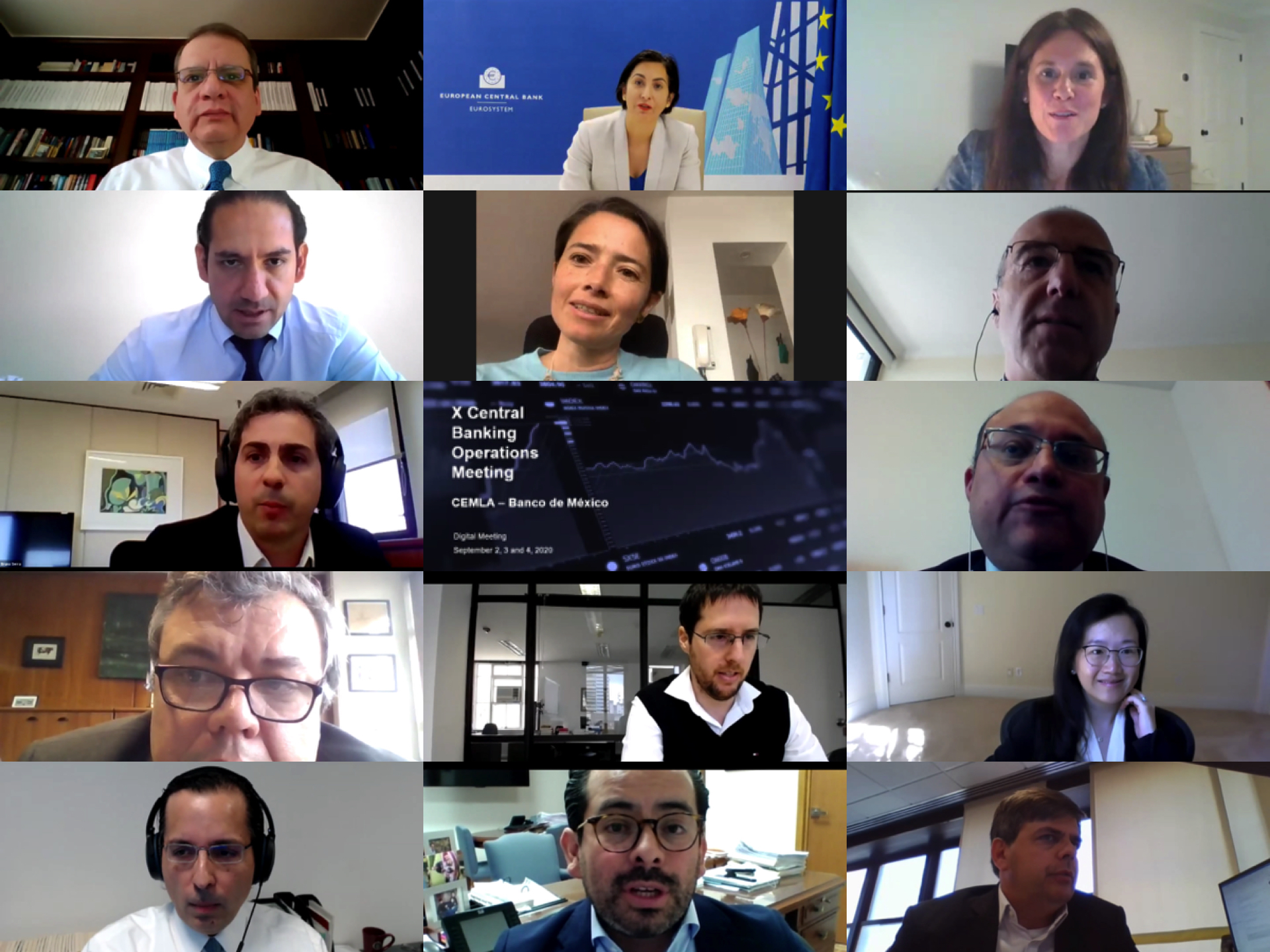
X Central Banking Operations Meeting
September 2, 3 and 4, 2020.
Manuel Ramos-Francia argued that the COVID-19 crisis is, in its origins, a significant public health contingency. It has meant a great effort for several authorities to respond to the increase in demand for health services. The fiscal policy has led the rest of the economic policy responses to COVID-19. Such policies have supported the public health responses, directly, by providing the needed funding to the public health sector and, in addition, have enabled the social distancing and related measures, with the provision of the appropriate incentives. It goes without saying that a global pandemic is not a monetary shock. This does not mean that central banks have not responded to the crisis. Quite the opposite, they have played key roles in the provision of liquidity to financial markets in distress and in enabling the continued provision of credit to the economy.
When facing the possibility of a systemic crisis, a central bank needs to respond in an timely, swiftly and vigorous way. This is crucial for several reasons, among which the following were underscored. First, a rapid and timely response is needed as financial markets liquidity can dry very quickly. It is known that, under conditions of financial systemic stress, markets can freeze rapidly, which could bring about very adverse implications. Second, the amount of support must create the view that it is enough to face the impending crisis. In other words, the amount of resources must convey a sufficiently strong signal so that investors think that the prospects of maintaining their financial positions in the economy are better than those of exiting them. Third, the transmission of financial stress can be severe; in particular, considering the nature of the liquidity and credit transmission channels, their interactions, and the presence of negative feedback loop mechanisms.
Nevertheless, this does not mean that the authorities setting up these facilities and policies should not recognize that their implementation can lead to difficulties. The design of policies and facilities needs to account for the appropriate incentive structure. Under conditions of systemic stress, calibrating the policies or facilities is a much more complicated endeavor. The implementation of policies and facilities to provide liquidity entail various kinds of measures, as was discussed at length during the meeting.
Imène Rahmouni-Rousseau began her presentation by describing how the COVID-19 crisis has challenged central banks, as they have had to respond to an unprecedented health crisis. In particular, the ECB deployed several programs, aiming for different channels, most notably, the bank lending one, addressing financial markets distress and the provision of foreign currencies. All of which should help maintain price stability in the euro area in the medium term. Conspicuously, the EU deployed its first shared fiscal response in history.
The measures taken have stabilized financial market conditions and, in tandem, assured credit allocation to the economy. There is also an important concern for monitoring the credit risk, given the impact of COVID-19. Hitherto, there have been limited rating downgrades. Having said that, if the health crisis endures, credit risk could deteriorate and with it, solvency concerns could appear.
In this context, it is important to maintain flexibility and, thus, calibrate central bank measures as a function of new data, prominently, market conditions. There is also the need to maintain fiscal support, should be commensurate with the economic shock’s size and be maintained for as long as it is needed.
The policies and facilities implemented by the Federal Reserve Board have always been of keen interest to central bankers and market participants globally. This is due to the fundamental role that the U.S. economy has in the world economy. The U.S. dollar is the dominant reserve currency, so the U.S. Treasury market plays a key role in the global financial system.
Lorie K. Logan provided participants with an overview of the Federal Reserve’s policy responses to COVID-19. First, she described the implementation of Treasury and agency MBS purchases in order to support market functioning and underscored the positive impacts of those purchases on financial markets. Second, she explained how the Federal Reserve has utilized market functioning indicators to monitor and assess the improvement in market conditions. Responding to a question, she stated that the broad set of Federal Reserve policy actions and facilities worked in concert to restore market functioning.
In addition, she covered the role of the U.S. dollar swap lines and the FIMA (Foreign and International Monetary Authorities) repo facility in addressing strains in international and domestic dollar markets, and the U.S. Treasury market. She highlighted that these facilities ultimately helped support the flow of credit to businesses, both in the U.S. and abroad.
With respect to emerging market economies (EMEs), CEMLA noted that one could argue that these facilities have been important for the region for, at least, two reasons. First, maintaining dollar liquidity is key to mitigating EMEs’ volatility, given the volatility of their capital flows. Second, EMEs’ corporates could encounter a sudden need for dollar liquidity given their level of corporate dollar-denominated debt.
Gerardo García explained that, Banco de México has addressed the pandemic with a two-stage approach, in four different dimensions. The first priority has been to foster the necessary conditions for financial markets to adjust in an orderly manner. Second, as financial markets stabilized, additional facilities have been implemented to provide more than enough liquidity, thus, offering mechanisms for risk management and strengthening the credit channels in the domestic economy. While doing so, four different dimensions have been considered: monetary policy, liquidity provision, credit channels, and the functioning of financial markets, as explained in more detail in his presentation.
For her part, Pamela Cardozo, explained that the policy actions taken by Banco de la República can be summarized in four broad categories: repurchase agreements, purchase of government and private bonds, reserve requirements and monetary policy rates, and FX interventions. In March interest rates increased and liquidity froze. On March 23 and April 16, the central bank announced that it was going to buy COP $2 trillion each month in government bonds. It bought COP $2 trillion in March and COP $0.8 trillion the next month. The first purchase of private bonds by the central bank was announced. On March 23, it announced it was willing to buy COP$10 trillion. To support credit, the central banks reduced the reserve requirement, from 7% to 5%. The monetary policy rate was reduced from 225 bps, from 4.25% to 2%. By March, the FX bid-ask spread had reached its highest level. Several actions were taken. For instance, the central bank sold FX swaps to mitigate the pressure from margin calls; it offered FX swaps to boost external credit, and it sold NDF during March, April and May, among other actions.
Beltrán de Ramón explained that one of Chile’s central banks’ objectives is to safeguard the adequate functioning of the financial system payments. It also has to procure markets functioning and financial stability. Thus, starting from October 2019, the central bank started developing measures to respond to shocks, and their implications, to the economy. Such measures include tools that provide liquidity in domestic currency and USD.
During March’s Monetary Policy Meeting, the Board decided to keep the monetary policy rate at 0.5% and conveyed to the public at large that it would consider options to complement the monetary policies by the further use of unconventional tools, if warranted. Six broad objectives were underscored. First, mitigate the volatility of the CLP in order to allow adequate price formation. Second, facilitate the management of liquidity in US$ in order to mitigate eventual tensions in the financial markets. Third, facilitate the management of liquidity in CLP. Fourth, contain volatility in the fixed income market. Fifth, provide liquidity, and support the flow of credit and the transmission of monetary policy. Sixth, mitigate volatility as a result of the changes in the Pension Fund portfolio.
Bruno Serra Fernandes explained that Brazil have had a significant fiscal policy response, which in terms of GDP is greater than many economies. Such a response has focused in companies and families. On the financial stability front, as of March, the BCB has taken several measures to increase system liquidity availability, with potential impact of 18% of the GDP. Reserves requirement have been reduced. A new loan facility to the banking system was opened, having as collateral private credit. There has been a reduction in the capital conservation buffer. Moreover, some regulation adjustments have allowed more flexibility on debt renegotiations during the pandemic. More recently, he pointed out, measures have focused on directing credit to small and medium-sized companies. Importantly, government programs that mitigate credit risk, with resources from the National Treasury, are complementary to the measures that the Central Bank of Brazil has taken.
He explained that the banking sector responded in a counter-cyclical manner. In tandem, that credit costs has decreased, and general economic activity has grown faster than expected. Having said that, economic activity in some sectors has remained depressed.
In its last meeting, the COPOM decided unanimously to reduce the Selic rate to 2.00% p.a. The COPOM believes that the current economic conditions continue to warrant an unusually strong monetary stimulus, but it also recognizes that the remaining space for monetary policy stimulus, if it exists, should be small. Prior to the crisis, the need was responding to market’s liquidity demand. During the pandemic, the use of all available instruments has been considered to maintain efficient market functioning. Bruno Serra Fernandes explained that the international reserves and net FX position are at near historical highs, relative to GDP, which is an advantage to the economy.
Paul Castillo started underlining that Peru’s GDP is expected to fall by 12.5% in 2020. The BCRP response needed to be fast, large and broad. There was a reduction of policy rate to historical minimum Reduction of the policy rate between March and April, from 2.25% to 0.25%, its historical minimum.
As for forward guidance, he explained that, the Board of Directors has emphasized that they consider it appropriate to maintain a strongly expansionary monetary stance for a prolonged period and will expand monetary stimulus. Specifically, the reduction of the reserve requirement in soles from 5% to 4% and of reserve requirement on FX external liabilities with terms below two years from 50% to 9%. In addition, they implemented a reduction in banks’ minimum current account requirement in soles with the BCRP from 1.0% to 0.75%, and there has been a suspension of the additional reserve requirement associated with dollar loans. To accommodate the income shock, households and firms have needed long-term financing, which depends on financial entities’ information on their clients. A rescheduling program has contributed to offset the adverse implications.
Mr. Castillo explained that maintaining the policy rate at ZLB entails risks. Nonetheless, a high level FX reserves and the FCL act as a buffer in case of pressures on the FX. Credit growth is currently supported by a loan guarantee program. Having said that, he explained that additional stimulus measures could be necessary later.
Adolfo Sarmiento explained some of the operational challenges they have faced. They implemented expansive monetary policy with a reduction in interest rate. In addition, reduction in bank reserve requirements to stimulate credit. Moreover, some extensions in the terms of credits have been implemented. The calculation of guarantees have been eased, as in other economies. What is more, there have been no operational incidents in the health emergency. Bank credit has been able to increased, partly supported by the measures implemented. Liquidity has been sufficient and importantly, it has been so, without observing an apparent impact on inflation expectations.
For his part, Mr. Feldman provided a broad overview of the monetary policy guidelines for the Central Bank of Argentina. He pointed out that some of the economic challenges that are being faced, were present previous to the Covid-19 crisis. One could argue that the health medical contingency brought about more challenges to the Central Bank of Argentina. He explained to us the main policies implemented, from which one can underscore three. First, adapting the financial system to social distancing measures Second, provide the financial relief for households and enterprises. This, he clarified, has two components. New loans to the private sector with subsidized interest rates. In addition, financial relief for loans that have been already granted loans. Third, protection of savings denominated in domestic currencies. He pointed out some immediate challenges such as managing the liquidity expansion. There has been transitory direct central bank financing to the treasury. He argued that the central bank has an adequate toolkit to manage excess liquidity.
Mr. Feldman pointed out the importance of the development of the local currency debt market to channel peso holdings. In addition, he underlined the relevance of international reserves, renewing the currency swap with PBOC, and the FIMA repo with the Federal Reserve. In addition, he explained the measures to stimulate savings in local currency in a context of falling interest rates. He described three additional measures. FX market intervention to reduce exchange rate volatility. Capital flow management measures protected the level of international reserves. He also described the reach to credit market segments with low bank presence, which was reinforcement by the SME lending scheme.
Mr. Feldman concluded by explaining that in the absence of an effective vaccine or treatment, high uncertainty about the economic outlook will continue. The main challenges for the central bank related to gradually remove the emergency financial measures, normalizing the foreign exchange market and consolidating credit growth, among others.
Wednesday, September 2
Opening remarks: Central Bank Response to COVID-19 ![]()
Manuel Ramos-Francia, Director General, CEMLA
Session 1. Central Banking Operations in Advanced Economies in times of COVID-19
Chair: Manuel Ramos-Francia, Director General, CEMLA
-
Extraordinary times require extraordinary action: The ECB and European response to COVID-19

Imène Rahmouni-Rousseau, Director General of Market Operations,European Central Bank -
The Fed’s Policy Response to Support Market Functioning During COVID-19

Lorie K. Logan, Executive Vice President, Markets Group, Federal Reserve Bank of New York
Session 2. Policy Responses to COVID-19 in Latin American Economies: A Central Banking Operations Perspective
Chair: Manuel Ramos-Francia, Director General, CEMLA
-
Liquidity provision in the Time of COVID-19. How much is enough?

Gerardo García López, General Director of Central Banking Operations, Banco de México -
The reaction of Banco de la República since March 2020

Pamela Cardozo, Chief Officer for Monetary and International Investments, Banco de la República
(Central Bank of Colombia)
Thursday, September 3
Session 3. Policy Responses to COVID-19 in Latin American Economies: A Central Banking Operations Perspective (continues)
Chair: Manuel Ramos-Francia, Director General, CEMLA
-
Unconventional Measures against the Social Crisis and the COVID-19

Beltrán de Ramón, Director of the Financial Markets Division, Banco Central de Chile
-
Policy Responses to COVID-19 in Brazil

Bruno Serra Fernandes, Deputy Governor for Monetary Policy, Banco Central do Brasil
Session 4. Policy Responses to COVID-19 in Latin American Economies: A Central Banking Operations Perspective (continues)
Chair: Santiago Garcia-Verdu, CEMLA and Banco de México
-
Challenges in the implementation of Monetary Policy in Latin America: Some lessons from the Peruvian experience

Paul Castillo, Chief Officer for Monetary Operations and Financial Stability, Banco Central de Reserva del Perú -
Policy responses to COVID-19 from the Central Bank of Uruguay

Adolfo Sarmiento, Chief Officer for Policy and Markets, Banco Central del Uruguay -
COVID-19 crisis: challenges and policy responses of the Central Bank of Argentina

Germán Feldman, Chief Economist, Banco Central de la República Argentina
Friday, September 4
Invited Lecture: Measuring the Macroeconomic Impact of Monetary Policy at the Zero Lower Bound
Professor Jing Cynthia Wu, Notre Dame University ![]()
Discussant: Santiago García-Verdú, CEMLA and Banco de México ![]()
Policy Roundtable
Chaired by Manuel Ramos-Francia, Director General, CEMLA
Participants:
- Juan García Padilla, Banco de México
- Beltrán de Ramón, Banco Central de Chile
- André Amante, Banco Central do Brasil
- Pamela Cardozo, Banco de la República (Colombia)
The current crisis is, in its origins, an extraordinary public health contingency. The economic policy responses have been led by the fiscal authorities. Such policies have not only supported medical responses directly but, in most cases, are designed to facilitate the social isolation measures providing the proper incentives to individuals, corporations and businesses. In tandem, central banks, through their facilities and policies, have been providers of liquidity and have enabled the provision of credit. In this context, there is a plethora of questions and issues to examine. To give some examples: how can one best assess such policies and facilities? How can one best determine collaterals in a situation of intense systemic stress? To what extent and how should EMEs’ central banks provide support to the long-end of the yield curve? Is the implementation of QE type of policies in EMEs possible or even reasonable? This last question considering that many EMEs have, in a not too distant past, a history of fiscal dominance. Do facilities aimed at easing credit provision to individuals and certain firms have the correct structure of incentives? How can one balance the short-term urgent needs with the potential long-term costs? To what extent have the international swaps lines and repos worked? What have been the main aims of FX interventions in this context?
Closing Remarks
Manuel Ramos-Francia, Director General, CEMLA
 André Amante is the head of the Open Market Operations Department at Banco Central do Brasil. He is responsible for implementing the BCB’s monetary operations, managing the central depository system for federal government securities, and providing assessments on monetary policy topics at the MPC meetings.
André Amante is the head of the Open Market Operations Department at Banco Central do Brasil. He is responsible for implementing the BCB’s monetary operations, managing the central depository system for federal government securities, and providing assessments on monetary policy topics at the MPC meetings.
Previously, he worked as a senior advisor in the same department from 2001 to 2018 and as a researcher in the BCB’s Research Department from 1999 to 2001. Mr. Amante holds a Master degree in Business Administration from the Coppead School of Business and a Bachelor of Science degree in Mechanical Engineering, both from the Federal University of Rio de Janeiro, Brazil.
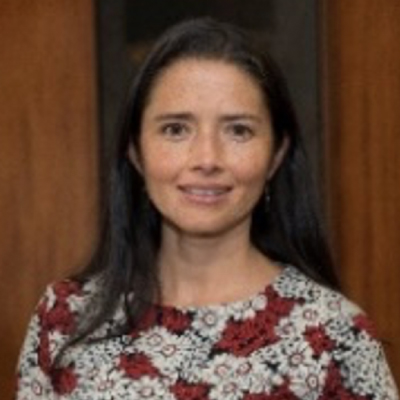 Pamela Andrea Cardozo has been Chief Officer for Monetary and International Investment in Banco de la República since October 2010. Previously, she was a researcher in the Monetary and Reserves Division in 2010, and a professional in Capital Markets from 2002 to 2005, both in Banco de la República.
Pamela Andrea Cardozo has been Chief Officer for Monetary and International Investment in Banco de la República since October 2010. Previously, she was a researcher in the Monetary and Reserves Division in 2010, and a professional in Capital Markets from 2002 to 2005, both in Banco de la República.
Pamela Cardozo obtained her Ph.D. in Economics from Queen's University. She holds a Master in Economics and a B.Sc. in Industrial Engineering, both from the University of Los Andes in Bogotá, Colombia.
 Paul Castillo has been in charge of the Monetary Operations and Financial Stability Management since March 2020.
Paul Castillo has been in charge of the Monetary Operations and Financial Stability Management since March 2020.
Previously, he served as Manager of Monetary Policy (November 2016 - March 2020), Deputy Manager of Monetary Policy Design (March 2008 - October 2016), Head of the Department of Policies of the Real Sector (September 2007 - February 2008), specialist in Research at the Economic Research Sub-management (December 2004 - August 2007), analyst at the Financial Analysis and Programming Department (May - September 1998) and analyst at the Non-Banking Financial Intermediation Department (May 1996 - December 1997). Paul Castillo joined the Bank in May 1996, after successfully completing the XLIII University Extension Course of the BCRP.
Mr. Castillo has a PhD in Economics from the London School of Economics and Political Science (2007), a Master's in Economics from the same university and he studied Economic Engineering at the National Engineering University.
He has participated in various international courses and seminars organized by the IMF, as well as various courses and seminars held at the Pontificia Universidad Católica del Perú, the Peruvian-German Chamber and the National Exporters Association, among others.
Mr. Castillo is a professor of the Master in Economics at the Universidad del Pacífico, a professor of the Economic Engineering Program at the National University of Engineering and of the Economics program of the Private University of Applied Sciences (UPC).
He is the author of research and publications on areas in which he is a specialist: Macroeconomics, monetary policy, and applied econometrics. His research has been presented at international conferences such as Computational Finance and Economics, LACEA, and various central banks.
 Beltrán de Ramón is the Manager of the Financial Markets Division of the Central Bank of Chile since January 2008. De Ramón is a Commercial Engineer from the Catholic University with a distinction in Economics. Previously, he served as Manager of National Financial Markets of the Central Bank of Chile since July 2005. He also worked for three years in the Budget Directorate of the Ministry of Finance, as the Head of the Public Finance Division. Likewise, he represented that Ministry as Director of the Public Companies System (SEP, for its acronym in Spanish) and was Director of the National Mining Company (ENAMI). Previously, since 1990 he held various positions at Copec S.A., serving between 1996 and 2001 as Head of Treasury and Subsidiaries.
Beltrán de Ramón is the Manager of the Financial Markets Division of the Central Bank of Chile since January 2008. De Ramón is a Commercial Engineer from the Catholic University with a distinction in Economics. Previously, he served as Manager of National Financial Markets of the Central Bank of Chile since July 2005. He also worked for three years in the Budget Directorate of the Ministry of Finance, as the Head of the Public Finance Division. Likewise, he represented that Ministry as Director of the Public Companies System (SEP, for its acronym in Spanish) and was Director of the National Mining Company (ENAMI). Previously, since 1990 he held various positions at Copec S.A., serving between 1996 and 2001 as Head of Treasury and Subsidiaries.
 Germán Feldman is the Chief Economist of the Central Bank of Argentina (BCRA). Mr. Feldman has as his duties to lead the economic research and academic activities to contribute to the design of the BCRA’s financial and monetary policies. Among other duties, he develops guidelines for the analysis and monitoring of the national and international economic context, as well as the monetary context and the money market.
Germán Feldman is the Chief Economist of the Central Bank of Argentina (BCRA). Mr. Feldman has as his duties to lead the economic research and academic activities to contribute to the design of the BCRA’s financial and monetary policies. Among other duties, he develops guidelines for the analysis and monitoring of the national and international economic context, as well as the monetary context and the money market.
He holds an undergraduate degree in Economics from Universidad de Buenos Aires and a master’s degree in Economics from Universidad de San Andrés. He also holds a PhD in Economics from Johann Wolfgang Goethe-Universität.
Prior to his current position at the Central Bank of Argentina, he was a member of the Board at the BCRA (2013-2016) and Superintendent of Financial and Foreign Exchange Institutions (2014-2015). Before working at the BCRA, he was an advisor at the Undersecretariat for Macroeconomic Programming, in the Ministry of the Economy of Argentina (2012-2013).
He has written various papers on Macroeconomics, Economic Development and History of Economic Thought. He was coordinator of Macroeconomics and Development Financing of the Master's Program in Economic Development at Instituto de Altos Estudios Sociales (IDAES|UNSAM), where he was also a Professor of Macroeconomics. He has given courses at Universidad Nacional Arturo Jauretche (UNAJ), Universidad Nacional de Quilmes (UNQ) and Instituto del Servicio Exterior de la Nación (ISEN). In addition, he has lectured in many conferences and seminars, both in Argentina and abroad.
 Gerardo García López is the General Director of Central Banking Operations of Banco de México, and as such, is responsible for the implementation of monetary policy, exchange rate policy, and the investment of the Central Bank’s foreign currency reserves. The Central Bank is also the financial agent of the Federal Government; therefore, Mr. García is also responsible for conducting debt management operations, executing FX transactions, and implementing hedging programs on behalf of the Mexican Government. His former responsibilities included the management of the International Operations Division of the Central Bank. Mr. García holds a B.A. degree in Economics from the Instituto Tecnológico de Monterrey (1999) and a Master in Business Administration (MBA) degree from Yale University (2005).
Gerardo García López is the General Director of Central Banking Operations of Banco de México, and as such, is responsible for the implementation of monetary policy, exchange rate policy, and the investment of the Central Bank’s foreign currency reserves. The Central Bank is also the financial agent of the Federal Government; therefore, Mr. García is also responsible for conducting debt management operations, executing FX transactions, and implementing hedging programs on behalf of the Mexican Government. His former responsibilities included the management of the International Operations Division of the Central Bank. Mr. García holds a B.A. degree in Economics from the Instituto Tecnológico de Monterrey (1999) and a Master in Business Administration (MBA) degree from Yale University (2005).
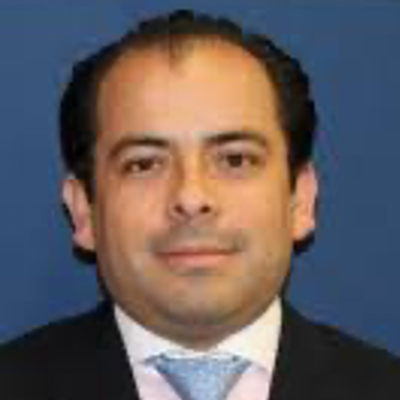 Juan García Padilla has a Bachelor degree in economics from Instituto Tecnológico y de Estudios Superiores de Monterrey, Campus Estado de México (ITESM-CEM), and a Master Degree in business administration with a major in financial administration, from the University of North Carolina. He has worked in Banco de México since 2001, where he has held several positions. First, he was trader at the peso-dollar market desk, then he became head trader. Later, he became head of the Secondary Market Operations Office, deputy manager and manager of the Market Operations Division. Currently, he is the Domestic Operations Director, responsible for implementing Banco de México’s monetary and exchange rate policy and Banco de México’s activities as financial agent for the Federal Government.
Juan García Padilla has a Bachelor degree in economics from Instituto Tecnológico y de Estudios Superiores de Monterrey, Campus Estado de México (ITESM-CEM), and a Master Degree in business administration with a major in financial administration, from the University of North Carolina. He has worked in Banco de México since 2001, where he has held several positions. First, he was trader at the peso-dollar market desk, then he became head trader. Later, he became head of the Secondary Market Operations Office, deputy manager and manager of the Market Operations Division. Currently, he is the Domestic Operations Director, responsible for implementing Banco de México’s monetary and exchange rate policy and Banco de México’s activities as financial agent for the Federal Government.
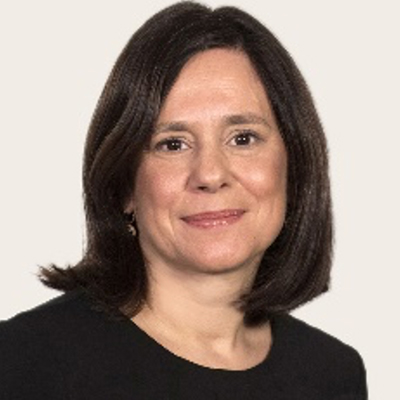 Lorie K. Logan is an executive vice president in the Markets Group of the Federal Reserve Bank of New York, manager of the System Open Market Account (SOMA) for the Federal Open Market Committee (FOMC), and head of Market Operations, Monitoring, and Analysis (MOMA). Ms. Logan’s responsibilities include the execution of monetary policy at the direction of the FOMC, provision of fiscal agent services to the U.S. Treasury Department in support of debt issuance and foreign exchange operations, analysis of global financial market developments, and production of reference rates, including the Secured Overnight Financing Rate (SOFR). Ms. Logan is also the senior New York Fed representative on several public-private committees advancing industry best practices, including the Treasury Market Practices Group (TMPG), the Alternative Reference Rates Committee (ARRC), and the Foreign Exchange Committee (FXC).
Lorie K. Logan is an executive vice president in the Markets Group of the Federal Reserve Bank of New York, manager of the System Open Market Account (SOMA) for the Federal Open Market Committee (FOMC), and head of Market Operations, Monitoring, and Analysis (MOMA). Ms. Logan’s responsibilities include the execution of monetary policy at the direction of the FOMC, provision of fiscal agent services to the U.S. Treasury Department in support of debt issuance and foreign exchange operations, analysis of global financial market developments, and production of reference rates, including the Secured Overnight Financing Rate (SOFR). Ms. Logan is also the senior New York Fed representative on several public-private committees advancing industry best practices, including the Treasury Market Practices Group (TMPG), the Alternative Reference Rates Committee (ARRC), and the Foreign Exchange Committee (FXC).
Ms. Logan played a prominent role in the development and implementation of the Federal Reserve’s crisis-era policies, including the expansion of the Federal Reserve’s balance sheet and the creation of liquidity facilities to mitigate systemic risks to the financial system. She was instrumental in the development of the Federal Reserve’s policy normalization tools, including the establishment of the overnight reverse repo facility, and the long-run monetary policy implementation framework. Ms. Logan’s public speeches and publications have focused on monetary policy implementation and central bank balance sheets, lender of last resort programs, reference rate reform, and market best practices.
Ms. Logan joined the New York Fed in June 1999 in the Policy and Analysis function in Bank Supervision. In 2000, she joined the Markets Group, where she has held successive leadership roles, including chief of staff and co-head of MOMA. Ms. Logan has been head of MOMA since 2014. Ms. Logan holds a bachelor’s degree in political science from Davidson College and a master’s degree in public administration from Columbia University.
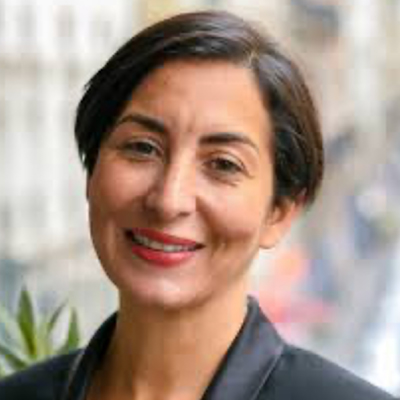 Ms. Rahmouni-Rousseau is currently Director General of Market Operations at the European Central Bank, a position she took up in February. Previously, she was Director of Markets at the Banque de France, a post she held since 2014.
Ms. Rahmouni-Rousseau is currently Director General of Market Operations at the European Central Bank, a position she took up in February. Previously, she was Director of Markets at the Banque de France, a post she held since 2014.
She started her career at the Banque de France in 1999 as an economist in the same directorate after working as an emerging markets equity analyst at Schroders Investment Management.
She moved to the ECB to work as an economist in the Directorate General Market Operations between 2001 and 2004 before returning to the Banque de France as Head of the Financial Stability and Markets Research Division. Ms. Rahmouni-Rousseau joined the Secretariat of the Financial Stability Board in Basel in 2009 and returned to the Banque de France in 2014.
Ms. Rahmouni-Rousseau holds a Master’s degree in economics from École Centrale Paris and a Master’s degree in economics and finance from Sciences Po in Paris.
 Manuel Ramos-Francia has a B.A. in Economics (with highest honors) from the Instituto Tecnológico Autónomo de México (ITAM). He was awarded a Fulbright Scholarship for graduate studies in the United States. He holds a Ph.D. in Economics from Yale University, where he graduated in 1993, specializing in Advanced Economic Theory and Financial Economics.
Manuel Ramos-Francia has a B.A. in Economics (with highest honors) from the Instituto Tecnológico Autónomo de México (ITAM). He was awarded a Fulbright Scholarship for graduate studies in the United States. He holds a Ph.D. in Economics from Yale University, where he graduated in 1993, specializing in Advanced Economic Theory and Financial Economics.
He has been Professor of Economics, having taught Advanced Macroeconomics, Open Economy Macroeconomics, Monetary Theory and Policy, and Financial Economics, and Director of the Center for Analysis and Economic Research at ITAM in Mexico. Dr. Ramos-Francia has held several positions at the Ministry of Finance: Deputy Minister (for Revenues), Chief Economist, and Chief Adviser to the Minister of Finance. He joined Banco de México in 2001, first serving as a Senior Adviser to the Board, then as Director General for Economic Research (Chief Economist) and, from April 2011 to December 2018, as Vice-Governor and Member of the Board. Currently, he is the Director General of the Center for Latin American Monetary Studies (CEMLA).
He has given seminars at Universities such as Yale Economics, Harvard Business, Harvard Law, Columbia Public Policy, the University of Chicago Business, and ITAM, among others. He has also given conferences and seminars at many central banks such as the Fed, the NY Fed, the Bank of Canada, the Bank of England, the Banque de France, and the central banks of Argentina, Ecuador, Jamaica, Peru, Guatemala, Turkey, and others, as well as at international financial organizations such as the IMF, the BIS, the World Bank, the IIF, and the IADB. Also, at organizations such as LACEA, LAMES, the International Economic Association (IEA), the Reinventing Bretton Woods Committee, and the Adam Smith Seminar. He has also been invited to be a member of the Bretton Woods Committee.
Manuel Ramos-Francia represented Mexico in the G20 Central Bank Deputies Group from 2010 to 2018. He was Chairman of the Deputies of the International Monetary and Financial Committee (IMFC) of the IMF from 2015 to 2017. Similarly, he presided over the Central Bank Deputies Group under Mexico’s G20 Presidency in 2012. He was given the Professional Merit Service Award from ITAM in 2009.
He has published various articles on monetary policy, fiscal policy, trade and applied econometrics in refereed economics journals such as: Journal of Money Credit and Banking, Economics Letters, Journal of Financial Stability, and Quarterly Journal of Finance, and many others, as well as in specialized books. He has refereed for journals such as: Journal of Money, Credit and Banking; Empirical Economics; Review of World Economics; International Journal of Economic Sciences and Applied Research; The World Economy, and others.
He is Editor-in-Chief of the Latin American Journal of Central Banking. Also, he was a member of the Association of the IJCB’s (International Journal of Central Banking) Management Committee.
 Adolfo Sarmiento is the Monetary Policy and Markets Manager at the Central Bank of Uruguay. Previously, he was Economic Advisory Manager in the same institution.
Adolfo Sarmiento is the Monetary Policy and Markets Manager at the Central Bank of Uruguay. Previously, he was Economic Advisory Manager in the same institution.
Mr. Sarmiento holds a degree in Economics from the Faculty of Economics and Administration of the UdelaR in 1991. In 1992, he obtained a specialization in Applied Macroeconomics at the Pontifical Catholic University of Chile and later in 1995 obtained the Master's degree in Applied Economics with distinction in Macroeconomics, awarded by the institution. In 1998, he obtained the Diploma in Finance from the ORT University of Uruguay.
He serves as Professor of Politics and Economic Planning in the Faculty of Economic Sciences and Administration of the University of the Republic, chair that has been part of 1998, previously he was the Chair of Macroeconomics (Economy II).
He is also a Professor of economic policy in the Bachelor of Economics of the Catholic University of Uruguay and academic reference and teacher of the Postgraduate degree in Finance of the same University. Previously, he served as Professor of Economics II in the Faculty of Economic Sciences and Administration between 1994 and 1995.
 Bruno Serra Fernandes is the Deputy Governor for Monetary Policy at Banco Central do Brasil. Previously, he was Senior Vice President, responsible for the proprietary fixed income desk at Banco Itaú Unibanco S.A. from 2014 to 2018. Mr. Serra Fernandes worked as senior portfolio manager on the Banking and Treasury department, Banco Itaú S.A. from 2007 to 2014. He was Manager of multimarket funds at BankBoston Asset Management from 2002 to 2005.
Bruno Serra Fernandes is the Deputy Governor for Monetary Policy at Banco Central do Brasil. Previously, he was Senior Vice President, responsible for the proprietary fixed income desk at Banco Itaú Unibanco S.A. from 2014 to 2018. Mr. Serra Fernandes worked as senior portfolio manager on the Banking and Treasury department, Banco Itaú S.A. from 2007 to 2014. He was Manager of multimarket funds at BankBoston Asset Management from 2002 to 2005.
Previously, Mr. Fernandes was fixed income strategist on the Asset Liability Management & Treasury at BankBoston in 2006. He published Impulso Fiscal: theory and practice - the Brazilian case: 1992-2002, his Master's dissertation advisors were Professors Dr. Fabiana Rocha (FEA-USP) and Dr. Afonso Bevilaqüa (PUC-Rio). He holds a Master's Degree in Economics from Universidade de São Paulo and a Bachelor's degree in Economics from IBMEC/RJ.
 Jing Cynthia Wu is the Dillon Hall Associate Professor of Economics at the University of Notre Dame and a Faculty Research Fellow at the National Bureau of Economic Research. Ms. Wu earned a PhD in economics from UC San Diego. Her research interests include monetary policy, zero lower bound, uncertainty, term structure of interest rates, and commodity futures markets.
Jing Cynthia Wu is the Dillon Hall Associate Professor of Economics at the University of Notre Dame and a Faculty Research Fellow at the National Bureau of Economic Research. Ms. Wu earned a PhD in economics from UC San Diego. Her research interests include monetary policy, zero lower bound, uncertainty, term structure of interest rates, and commodity futures markets.
Ms. Wu has published in American Economic Review, Journal of International Economics, Journal of Econometrics, International Economic Review, and Journal of Money, Credit, and Banking. She has served as a panelist at the National Science Foundation, and an associate editor at the Review of Economics and Statistics and Journal of Empirical Finance.
Her work has been cited by past Federal Reserve Chair Ben Bernanke, Janet Yellen, current Chair Jerome Powell, Bloomberg News/Businessweek/View, The Wall Street Journal, Forbes, The New York Times, Business Insider among others. Recently, she proposed a "shadow rate" to study the economic effects of quantitative easing. Her shadow rates are published by the Federal Reserve Bank of Atlanta, Haver Analytics, Thomson Reuters, and Bloomberg, and used for policy analyses among central banks. She holds a Ph.D. from the University of California, San Diego.

